American Beautyberry, Callicarpa americana
American Beautyberry, Callicarpa americana is native to North America. It’s truly a beauty with lime-green leaves and magenta-colored berries! Beautyberry are LOW-care plants, pest and disease-free, and deer do not eat it! Callicarpa includes many varieties of Beautyberry including the Black, Pearl Glam, Purple and Japanese Beautyberry. There are many varieties of Beautyberry.
Callicarpa americana fit any landscape design and grows in full sun or full shade. Some US state nurseries offer American Beautyberry for free or at a low price. Berries can be eaten fresh, or made into a jam, preserve or even wine! Also, the USDA has proven that it is a mosquito AND tick repellent. Also, caring for the plant is beyond easy.
Beautyberry is unique plant. I scratched my head when I first saw it. How does the plant called Beautyberry exist, requires no-care and virtually no one knows about it? Beautyberry is good looking, different, showy, tasty, forgiving, and…has insecticide properties. Get on-board! We grow the American Beautyberry with various colored berries (pink, magenta and white).
5 reasons to grow Beautyberry
- “Wow” factor: very unique looking; no other plant looks like it
- Edible berries with a “pop”
- A natural mosquito repellent
- Fits any garden idea
- Easy: grows in any sun, any soil, & disease-free
________________________________________
see our list of 400 edible plants
YouTube channel (please subscribe)
Beautyberry in garden design, permaculture & organic gardening
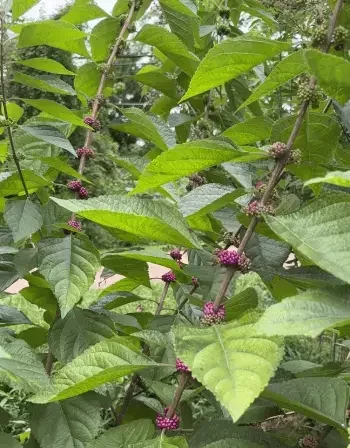
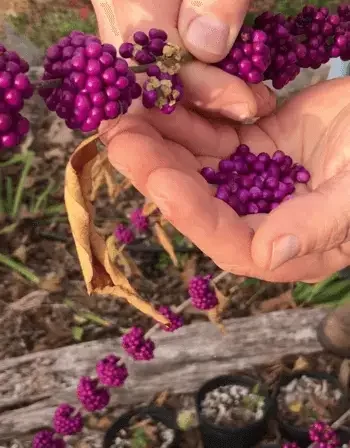
American Beautyberry, Callicarpa americana
common names: Beautyberry, American Beautyberry, French Mulberry, Sourbush, Bunchberry, Purple beauty-berry.
Fact Sheet
Zone: 6 to 10
Height: 3 to 6 feet
Native: North America
Bloom Time: June – August
Bloom Color: pink
Fruit Maturity: August – October
Self-fertile: yes (hermaphrodite)
Sun: full sun to full shade (fruits and flowers best with 1/2 day sun)
Water: low
Soil: forgiving
Maintenance: low
Growth Rate: fast
Deciduous or evergreen: deciduous
Edible¹: yes (more information is below)]
Medicinal²: yes (discussed below)
Commercial viability: strong (discussed below)]
Family / Genus: Lamiaceae / Callicarpa
Remarks: zero maintenance plant; drought tolerant; disease and pest free, exceedingly attractive late-Summer/Fall foliage and fruit; and an important food for birds (in November, if berries remain in the plant).
As an Amazon Associate, HEPPY earns from qualifying purchases (paid link).
Here’s a list of all the products we truly use and trust.
Varieties of Beautyberry
American Beautyberry (Callicarpa americana)
The American Beautyberry are native to North America. It has lime-green leaves contrasted by magenta-colored berries. However, it produces white berries in rare cases. That variety is called ‘Lactea’ or ‘Alba’. Another variety has pink berries (‘Welch’s Pink’)! Overall, they all are Callicarpa americana!
Black Beautyberry or Mexican Beautyberry (Callicarpa acuminata)
Black Beautyberry is native to central and south America. Callicarpa acuminata resembles our American Beautyberry except it’s shorter in height and the berry-clusters are…black ;). Well, definitely, dark. Callicarpa acuminata grows in zones 8 to 10.
Bodinier Beautyberry or Profusion Beautyberry (Callicarpa bodinieri)
Bodinier Beautyberry is native to China. Callicarpa bodinieri resembles our American Beautyberry except its berries are lilac in color. ;). ‘Profusion’ is a common cultivar of Callicarpa bodinier and won the Award of Garden Merit of the Royal Horticultural Society. Bodinier Beautyberry grows in zones 6 to 8.
Chinese Beautyberry (Callicarpa cathayana)
Chinese Beautyberry is native to China. Callicarpa cathayana resembles our American Beautyberry except its berries are, generally, shades of pink. The Chinese Beautyberry grows in zones 5 to 8.
Japanese Beautyberry (Callicarpa japonica)
This variety is very much like the Purple Beautyberry (Callicarpa dichotoma). Clusters of purple berries develop off small stems that connect to its branches. That’s the major distinction between Asian and American Beautyberry plants. The American Beautyberry, Callicarpa americana develop berries right along its branches. The Japanese Beautyberry grows in zones 5 to 8.
Pearl Glam Beautyberry (Callicarpa x ‘NCCX2’)
This girl was made in a laboratory! Pearl Glam Beautyberry grows more upright and compact. That’s a plus. Foliage is purple, and berry-clusters are “luminous-violet.” Where we became unHEPPY with this beautiful plant is the price being charged to buy it. ~$15 for a 4.5in Qt is really expensive.
Purple Beautyberry or Early Amethyst (Callicarpa dichotoma)
Native to China, Korea and Japan, the Purple Beautyberry (Early Amethyst) may be an invasive plant. I’ve read at least one nursery stopped selling this variety. Two species names are used interchangeably. Purple Beautyberry can be Callicarpa dichotoma or Callicarpa purpurea (USDA PLANTS database). Callicarpa dichotoma grows in zones 5 to 8.
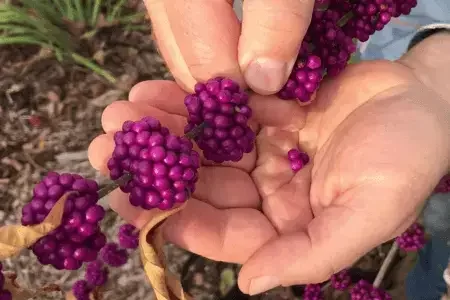
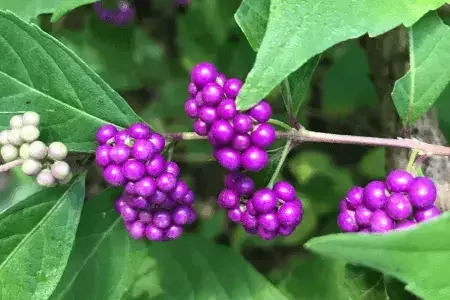
As an Amazon Associate, HEPPY earns from qualifying purchases (paid link).
Beautyberry in landscaping and garden ideas
The American Beautyberry is native to North America. It is a LOW-care plant with exotic features!
Landscape Architecture
Use American Beautyberry in landscape architecture. It’s an attractive low maintenance plant. It grows to 6 feet tall in full sun. However, in the shade it grows wider than tall.
Callicarpa ‘force’ people to stop and ask, what is it? The foliage is an attractive lime-green that is accented by many, well organized clusters of magenta-colored berries (August – November). The leaves and berries are evenly spaced on the Beautyberry’s 3’ long, softwood thin branches. The clusters of fruit remain on the plant into Fall. Beautyberry’s attractive and unusual characteristics fit any architectural design.
Garden Ideas
Beautyberry fits backyard and front yard garden idea because it’s adaptable. Prune Callicarpa to any shape. Growing Callicarpa as a single specimen plant is possible. It also functions as a border plant, hedge, along a fence, or mixed into a larger ornamental garden. Used the American Beautyberry in a rain garden, native garden or pollinator garden.
Branches and foliage are open and ‘airy’. Prune as needed — the Beautyberry tolerates heavy pruning. This is an attractive and unusual plant that fits any garden idea!
Callicarpa americana for free
In Maryland, contact your Department of Natural Resources (DNR) county representative. Ask about the Backyard Buffer program. The DNR offers native specimens for no-cost. Check your State or local Dept. of Natural Resources.
Callicarpa americana for nearly free
Maryland’s DNR has an online catalog to order native plants for $2.00 – $3.00 each! However, you have to buy 25 plants minimum. Search
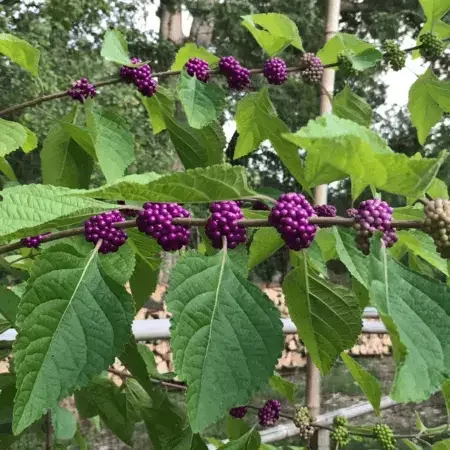
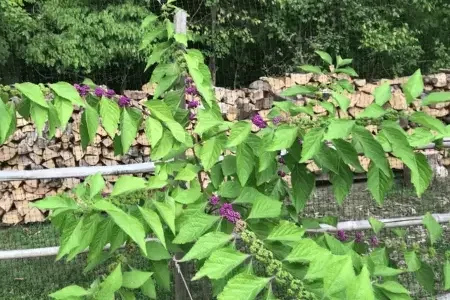
As an Amazon Associate, HEPPY earns from qualifying purchases (paid link).
edible Beautyberry - how it can be eaten and used medicinally
1, 2 HEPPY cannot take any responsibility for any adverse effects from the use of plants. Always seek advice from a professional before using a plant for food or medicinally. This information is intended for educational purposes only and should not be considered as a recommendation or an endorsement of any particular medical or health treatment.
Edible berries
Fully ripe American Beautyberry fruit are a deep magenta color. We pick them in October through November in zone 7.
Ripe Beautyberries have a lemony ‘pop’ flavor. Sometimes the berries have a hint of sweetness. However, sometimes there is only a light flavor. Eat Beautyberries fresh off the plant or in salads. The fruit has a crunchy pop. Also, make jams/jellies and some make wine! Pick the American Beautyberry berries when the fruit is as dark; immature fruit lack flavor are astringent.
Recipes
If you can withstand the ads on this website, this webpage shows how to make jelly, and how to water can. The ingredients and instructions are about half way down the page.
American Beautyberry medicinal qualities
According to the USDA, “The roots, leaves and branches of the American beautyberry were used by the Alabama, Choctaw, Creek, Koasati, Seminole and other Native American tribes for various medicinal purposes. The roots, leaves and branches were made into a decoction that was used in sweat baths to treat both malarial fevers and rheumatism. The boiled plant parts were poured into a big pan that was placed near the patient inside a sweathouse. A similar decoction of the roots was used to treat dizziness and stomachaches…[and more]’”
a NIH publication that studies the efficacy of Callicarpa americana against cancer cells writes, “Preparations of the bark of C. americana have been used to treat fever, the leaves to treat dropsy, and the roots to alleviate colic, dysentery, and skin cancer. The roots and branches have been used in preparations intended to relieve malaria, rheumatism, and fever. The leaf essential oils of C. americana have antialgal and mosquito-deterrent properties, and numerous essential oil components have been identified from the leaves of C. americana.” sadly, the publication is too complex for us to understand how C. americana succeeded, or not succeeded, in fighting cancer cells. the study was “Dedicated to the late Dr. Kenneth L. Rinehart of the University of Illinois at Urbana-Champaign for his pioneering work on bioactive natural products.”
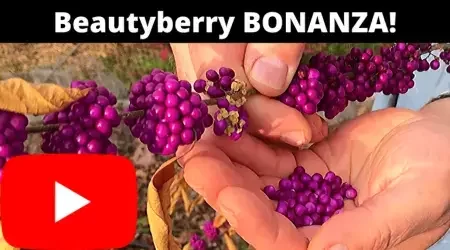
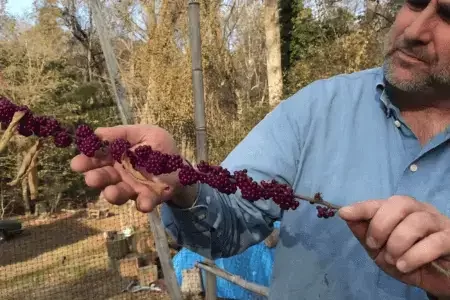

American Beautyberry products
the commercial viability is strong. the name ALONE is a branding success – how in the world does a plant named, “Beautyberry” not attract interest? Beauty and berry! What’s not to pull people in?!
Callicarpas are spectacular looking plants with a “wow” factor, is farmers-market ready, and has proven insecticidal properties.
Commercial or private landscaping
I challenge someone to find a more spectacular looking plant under 10’ tall. it’s ideal for landscaping sales. the Beautyberry has long, thin and elegant branches that are perfectly accented with consistently spaced lime-colored leaves and magenta-colored clusters of berries. it it looks spectacular in the Fall; after the leaves drop, the uniquely imbued clusters of berries remain on the plant.
the plant is easy to propagate, and easy to care for. it has a “wow” factor, and is largely unknown. why private (your backyard) and commercial landscapers don’t grow and offer this plant is WAY beyond me.
Farmers’ market or cottage food industry
ripe fruit are delicious. it’s unusual; it has a lemony and crunchy ‘pop.’ again, there’s a ‘wow’ factor. BE SURE to use deep-magenta colored, FULLY ripe fruit. otherwise, it’s astringent. it’s best to harvest and sell on the same-day at a farmers market, or to restaurants. the berries keep well in the fridge, and can be refrigerated for about a week.
whether making jam, jelly or even wine, the end product is boosted by the name, Beautyberry. and the plant is a prolific fruiter if grown in a sunny location (3/4+ of sun)
think BIG: Beautyberry is a NATURAL mosquito repellent and tick repellent
the United States Department of Agriculture, Agriculture Research Service (USDA-ARS) confirmed that Beautyberry oils ward off biting insects such as ticks, ants and mosquitoes. the oils are in fresh, crushed leaves. the University of Mississippi’s National Center for Natural Products Research and the USDA-ARS have collaborated on this since 2005. It turns out that a “A chemical compound isolated from the plant, callicarpenal, was effective as a mosquito repellent in a laboratory experiment using a simulated skin model.”
the entire story is amazing; essentially, when a researcher (Charles T. Bryson) was a child, he witnessed his grandfather (John Rives Crumpton) using Beautyberry as a repellent. Mr. Crumpton used Beautyberry to bring relief to his horses from deerflies and horeflies! (if you don’t know these flies your lucky — they are BIG, they BITE and are RELENTLESS.) as an adult, the researcher mentioned it to his USDA-ARS supervisor and the rest is history.
Three repellent chemicals were extracted: callicarpenal, intermedeol and spathulenol. The research concluded that all three chemicals repulse mosquitoes known to transmit yellow fever and malaria. Mosquitoes carrying the West Nile virus were not tested as part of the study, but the USDA-ARS has since filed a patent application to use callicarpenal as an anthropod repellent.
UNVERIFIED by HEPPY is this Beautyberry Natural Insect Repellent and Insect Repellent Cream. Be cautious
there’s a lot to explore and we invite interns and volunteers to focus on the commercial viability of the Beautyberry here at HEPPY. also, please help us fund our work follow our Beautyberries on YouTube (and please subscribe), and consider donating (info@heppy.org) or volunteering at HEPPY!
As an Amazon Associate, HEPPY earns from qualifying purchases (paid link).
Caring for Beautyberry: growing, pruning and harvesting
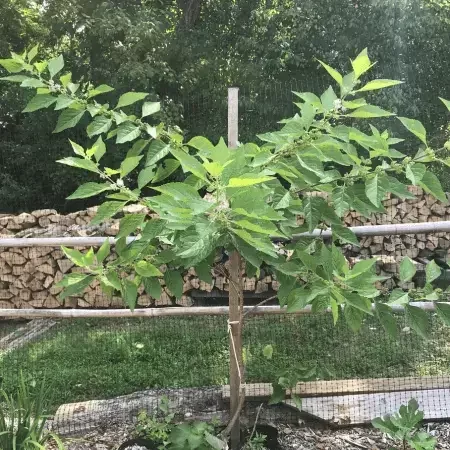
Beautyberry, Callicarpa plants are forgiving. They tolerate many soils and any amount of sunlight. However, they grow best in rich organic soil and full sun.
We grow American Beautyberry different amounts of sunlight. Full sun to full shade. Always grown in rich soil. Callicarpa americana grow well in all locations. However, fruiting and growth is low in full shade.
Pruning
Beautyberry flower on the current year’s growth. So there’s no harm in giving the Beautyberry a heavy winter or early Spring prune.
Prune heavily if the plant is growing poorly. Prune gangly branches or branches producing few leaves or fruit. Or, prune to shape the plant. On the other hand, our well-growing Beautyberry are left alone. The 4’ tall plant (3/4 sun) and 2’ plants (full shade) have excellent shape.
Harvesting
We harvest right on YouTube!! It was filmed over a four month period. Harvesting is shown at two parts in our vid.
Follow our BEAUTIES on YouTube (and please subscribe), and consider donating to or volunteering at HEPPY!
Propagating Beautyberry: cuttings, division, grafting, layering and seeding
HEPPY’s Beautyberry are now reaching maturity.
Self-seeding American Beautyberry
Beautyberry will self-seed moderately. Consequently, self-seeding is our favorite method of propagation. Self-seeding plants are easily transplanted or potted for sale.
Layering American Beautyberry
Mound layering is a simple layering technique. Bury a low-to-the-ground branch in soil. At least 6″ of branch, in at least 2″ in soil. Cover the buried location with a brick. Then, check back in a year 😉 Be sure to leave least 12 inches of the branch tip out of the soil. Also, I stake that 12″ portion upright so I don’t step on it ;). Staking also allows the new plant to develop straight.
Propagation Protocol: Callicarpa americana
this site provides detailed information on propagating Beautyberry by seed.
Volunteer at, or donate to HEPPY to move this project along!
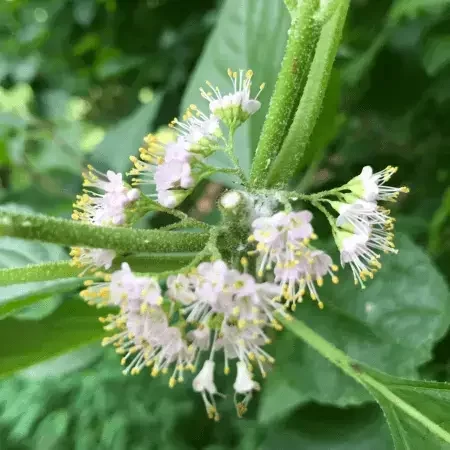
As an Amazon Associate, HEPPY earns from qualifying purchases (paid link).
American Beautyberry (Callicarpa americana) growing at HEPPY
We grow American Beautyberry, Callicarpa americana grow in a variety of locations. Full shade, partial shade, and full sun.
Also, we finally planted the other color variants of Callicarpa americana. The White and Pink American Beautyberries!
Common American Beautyberry
The “common” variety of American Beautyberry has magenta colored berries. We have many of them and they thrive.
Recently, I noticed that the American Beautyberry is SUPER drought tolerant (in rich soil). Also, it grows tall and full in full sun. However, in part shade it grows wider than tall.
It’s my impression that individual plants vary in growth and vigor. For example, the one with the largest root mass (largest pot) is grew poor. Conversely, I transplanted a very small Beautyberry it’s thriving the best.
Pink American Beautyberry, ‘Welch’s Pink’
Welch’s Pink is an variant of the American Beautyberry, Callicarpa americana. It was found by Matt Welch in east Texas and its seeds are true to the pink color.
It tolerates many conditions, as all American Beautyberry. However, it develops beautiful pink berries in September, and grows 4-6 feet tall and wide so is a little smaller (NC State University, Cooperative Extension).
Callicarpa americana, Welch’s Pink was purchased from Colesville Nursery. It’s a small business in Virginia.
White American Beautyberry, ‘Lactea’ or ‘Alba’
We just planted the White American Beautyberry, Callicarpa americana.
As with all American Beautyberry, it tolerates many conditions. However, it develops beautiful white berries in September.
Callicarpa americana, Alba was purchased from Colesville Nursery. It’s a small business in Virginia.
We’re learning about these lovely plants and after three years, we’re getting well-established Beautyberries.
Follow our BEAUTIES on YouTube (and please subscribe)., And, consider donating or volunteering at HEPPY!
References
Missouri Botanical Garden: Callicarpa americana
USDA PLANTS Database: Callicarpa americana L., American beautyberry
Scientists Confirm Folk Remedy Repels Mosquitoes. SciemceDaily.com
United States Department of Agriculture, AgResearch Magazine: Learning from our elders Folk Remedy Yields Mosquito-Thwarting Compound



